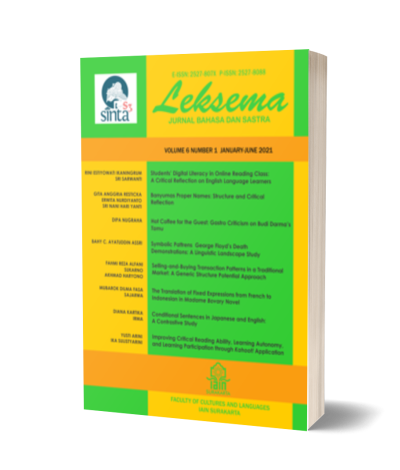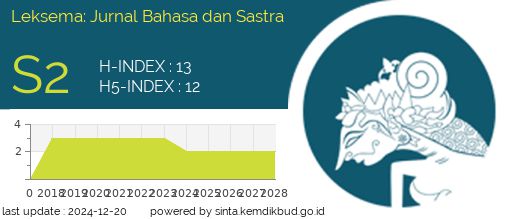CRITICIZING YOGYAKARTA ENVIRONMENT ON THE OFFICIAL WEBSITE OF INDONESIAN TOURISM: AN ECOLINGUISTIC STUDY
DOI:
https://doi.org/10.22515/ljbs.v5i1.2023Keywords:
Yogyakarta, ecolinguistics, tourism, environment, transitivityAbstract
Tourism is one of the sectors which defines the identity of a country. In Indonesia, rich in culture and nature, the use website is benefited by the government to portray as well as gain profit from the tourism sites. This paper, thus, intends to discuss how the environment in Yogyakarta tourism is criticized on the website. The interest of linguistics to criticize how its usage affects the environment triggers the development of ecolinguistics. Saphir distinguishes three ecological territories: physical, economic and social. Ecological domains are exercised to present Yogyakarta on Wonderful Indonesia, the official website of Indonesian tourism. This paper observed the employment of clauses of Yogyakarta text found in the Destination Highlight on the front page of the website at www.indonesia.travel on March 31, 2019. The method applied is ecolinguistics by exercising the ideational metafunction of language proposed by Halliday's Systemic Functional Linguistics (SFL) to figure out how the website portrays the real world of Yogyakarta environment seen from the choice of process, participants and circumstances. The analysis reveals that social environment dominates the website, meaning that Yogyakarta is advertised as a carrier and attribute in terms of its culture and value. Yogyakarta, is attached to the attributes as a city with respect for values. This paper proposes criticizes to present Yogyakarta through material processes to demonstrate how local people, as well as tourists, value and engage in preserving the environment of Yogyakarta.
Â
Downloads
References
Antara. 2019. “Yogyakarta Optimistic to Reach 10 Increase in Tourist Visits.†Tempo. Last modified September 23. https://en.tempo.co/read/915229/yogyakarta-optimistic-to-reach-10-increase-in-tourist-visits
Chen, S. 2016. “Language and Ecology: A content Analysis of Ecolinguistics as an Emerging Research Field.†Ampersand 3 (1): 108-116.
Dastenaee, MT & Poshtvan, H. 2018. “A Critical Review of Ecolinguistic studies in Iran.†International Ecolinguistics Association, 1-10.
Ezzina, R. 2015: “Transitivity Analysis of The Crying a Lot of 49 by Thomas Pynchon.†International Journal of Humanities and Cultural Studies, 2 (3): 283-293.
Fairclough, N. 1995. Critical Discourse Analysis: The Critical Study of Language. New York: Longman,
Fill, A & P. Muhlhauser. 2001.The Ecolinguistics Reader: Language, Ecology, and Environment. New York: Continuum
Ginting, N & S. Halim. 2019. “Environmental Approach on Optimizing Tourism Facilities at Tourism Village in Indonesia.†7th AicQoL 2019:109-116. Bali: e-International Publishing House, Ltd, UK. doi:10.21834/e-bpj.v4i10.1617
Hassan, H. 2014. “The Representation of Malaysian Cultures in Tourism Brochures.â€Procedia, 118: 140-151
Indonesia Batik: A Cultural Beauty. 2018. Jakarta: Ministry of Trade of the Republic of Indonesia
Magio, OK, VM. Velarde, Carlos Alberto Rios G & MAN Santillan. 2013.â€Ecotourism in Developing Countries: A Critical Analysis of the Promise, the Reality and the Future.†Journal of Emerging Trends in Economics and Management Sciences. 4(5): 481-486
Manan, S. 2001. “Re-reading the Media: A Stylistic Analysis of Malaysian Media Coverage of Anwar and the Reformasi Movementâ€. Asia Pasific Media Educator: 39-54
Pranita, D. 2018. “Digitalization: The Way to Tourism Destination's Competitive Advantage (A Case Study of Indonesian Marine Tourism)â€. The Importance on Advancing Vocational Education to Meet Contemporary Labor Demands:243-253. KnE Social Sciences. doi:10.18502/kss.v3i11.2763
Pratama, EH. 2016. “Evaluasi Branding Jogja Never Ending Asia Sebagai Strategi Memasarkan Daerah di Era Otonomi.†Jurnal Ilmu Sosial Mahaka, 5 (1): 1-20
Priatmoko, S. 2018. “Working Rural Ecotourism Planning in Yogyakarta Using MSP+DM Analysis.†E-Journal of Tourism, 5 (1): 22-29
Putri, FA & Adinia, NC. 2018. “The Role of Communication in Sustainable Development Tourism: A Case Study on Community-based Tourism (Pokdarwis) in Nglanggeran Village.â€Jurnal Komunikasi Indonesia, 7 (2): 153-161
Salim, MA, NA Ibrahim, & H Hassan. 2012. “Language for Tourism: A Review of Literature.†Procedia: Social and Behavioral Sciences: 136-143. doi:10.1016/j.sbspro.2012.11.255
Steelyana, E. 2012. “Batik, A Beautiful Cultural Heritage that Preserve Culture and Support Economic Development in Indonesia.†Binus Business Review, 3 (1): 116-130.
Stibbe, A. 2015. Ecolinguistics: Language, Ecology and the Stories We Live by. London: Routledge
Syahid, AR. 2014. Studi Pariwisata. https://studipariwisata.com (Retrieved September 28, 2019)
Downloads
Published
Issue
Section
License
The copyright of the received article shall be assigned to the publisher of the journal. The intended copyright includes the right to publish the article in various forms (including reprints). The journal maintains the publishing rights to published articles.
In line with the license, the authors and users (readers or other researchers) are allowed to share and adapt the material only for non-commercial purposes. In addition, the material must be given appropriate credit, provided with a link to the license, and indicated if changes were made. If authors remix, transform or build upon the material, authors must distribute their contributions under the same license as the original.







